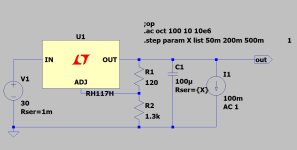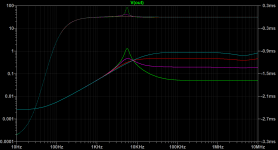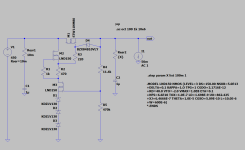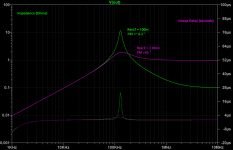You set the source voltage to DC, set the current load to AC=1, with DC current at 50mA. Analysis mode = AC, 100 points per octave, 10 to 10MHz. Then the vertical axis in Ohms will be V(out) as the denominator is "1"By using the formula you gave me on the first reply to the topic:
Change the right vertical axis to "Group Delay" and you can easily calculate stability. Here's an LM317 example to demonstrate stability under various C(out) ESR:
Attachments
If you add 1 ohm in series with the output, the effective output impedance is the same as simply the output MOSFET with its gate connected to the zener stack!
You have to ask yourself - what does adding the error amplifier help you with, in exchange for its trouble? That's even before you compare the sound.
You have to ask yourself - what does adding the error amplifier help you with, in exchange for its trouble? That's even before you compare the sound.
Rod makes a very good point -- the error amplifier (in this case a single depletion MOSFET) -- may distort, putting harmonics of the fundamental onto the power supply rails. If the amplifier PSRR itself is "weak" you're going to hear the signal "smudged".
I have demonstrated this with Erno Borbely's excellent all jfet preamplifier which has only 40dB of PSRR. You can hear the effects of different voltage regulators on the sound, and it doesn't take "golden ears" to witness the effect. The knowledge of this effect arises from a kind letter written by a DIYAUDIO member to the editor of Linear Audio and not original to me!
.
My advice it's not going to cost you a lot to hear various power supply schemes. Try listening to them with recorded piano music, male voice, and a lot of percussive instruments.
I have demonstrated this with Erno Borbely's excellent all jfet preamplifier which has only 40dB of PSRR. You can hear the effects of different voltage regulators on the sound, and it doesn't take "golden ears" to witness the effect. The knowledge of this effect arises from a kind letter written by a DIYAUDIO member to the editor of Linear Audio and not original to me!
.
My advice it's not going to cost you a lot to hear various power supply schemes. Try listening to them with recorded piano music, male voice, and a lot of percussive instruments.



